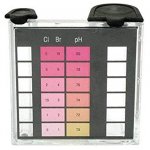Hi All,
I've got a new pool and have been through all the basic chemistry instructions, read the pool school ebook and recommended articles. I also bought a Taylor test kit and have been adjusting the pool water for about a month. It's pretty close to the recommended levels.
A couple of questions about testing:
1) The test kit talks about the need to test within a minute of sampling from the pool. They claim that time can influence the test results. However, given the number of tests and the time it takes to conduct each, this seems unattainable. Comments?
2) The test kit also talks about the need to get the exact amount of pool water for each test (down to the drop!). I can see that the wrong amount of water would affect the test, but to the drop! Really? How sensitive are these tests to a drop's difference in the pool water?
3) As I have reduced the pH over the last couple of weeks (using muriatic acid), the TA has gone down (obviously, since lower pH is more acidic). Is there a way to increase the TA without increasing the pH?
One additional question, not directly about testing but related:
4) I've spent some time estimating the pool volume. Since it's an irregular shape with varying depths, I've broken it down into four circles and calculated the volume based on that. There's still an area (of varying depth) that's not covered by the circles, so I'm still working on a better estimation. My volume turns out to be approximately 11.6K, so I've scaled the lookup tables provided in the kit. I interpolated the values between 10K and 15K using linear scaling. I hope that is an appropriate scaling. Comments?
I've got a new pool and have been through all the basic chemistry instructions, read the pool school ebook and recommended articles. I also bought a Taylor test kit and have been adjusting the pool water for about a month. It's pretty close to the recommended levels.
A couple of questions about testing:
1) The test kit talks about the need to test within a minute of sampling from the pool. They claim that time can influence the test results. However, given the number of tests and the time it takes to conduct each, this seems unattainable. Comments?
2) The test kit also talks about the need to get the exact amount of pool water for each test (down to the drop!). I can see that the wrong amount of water would affect the test, but to the drop! Really? How sensitive are these tests to a drop's difference in the pool water?
3) As I have reduced the pH over the last couple of weeks (using muriatic acid), the TA has gone down (obviously, since lower pH is more acidic). Is there a way to increase the TA without increasing the pH?
One additional question, not directly about testing but related:
4) I've spent some time estimating the pool volume. Since it's an irregular shape with varying depths, I've broken it down into four circles and calculated the volume based on that. There's still an area (of varying depth) that's not covered by the circles, so I'm still working on a better estimation. My volume turns out to be approximately 11.6K, so I've scaled the lookup tables provided in the kit. I interpolated the values between 10K and 15K using linear scaling. I hope that is an appropriate scaling. Comments?



